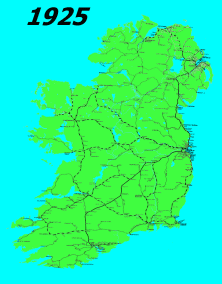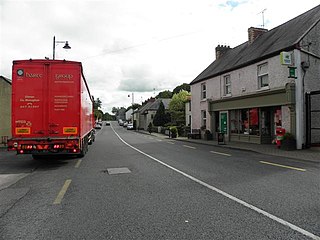
The history of rail transport in Ireland began only a decade later than that of Great Britain. By its peak in 1920, Ireland had 3,500 route miles (5,630 km). The current status is less than half that amount, with a large unserviced area around the border area between Northern Ireland and the Republic of Ireland.

Royal Hillsborough, more commonly known simply as Hillsborough, is a village and civil parish in County Down, Northern Ireland, 19 km (12 mi) from the city of Belfast. It is within the Lisburn and Castlereagh District Council area. The village is noted for its Georgian architecture. It is home to Hillsborough Castle, the British royal family's official residence in Northern Ireland, and residence of the British Secretary of State for Northern Ireland.

The Ulster Transport Authority (UTA) ran rail and bus transport in Northern Ireland that operated from 1948 until 1967.

The N12 road is one of the shortest national primary roads in the Republic of Ireland, running 6.87 km (4.27 mi) from outside Monaghan to the border with County Armagh, Northern Ireland, at Ardgonnell Bridge outside Middletown. The N12 is part of an overall route running from Cavan Town to Belfast.

Laurencetown or Lawrencetown is a small village in County Down, Northern Ireland. It sits on the River Bann, along the main road between the towns of Banbridge and Portadown. It is within the parish of Tullylish and covers the townlands of Knocknagore and Drumnascamph. In the 2011 census it had a population of 956 people. In Irish, it is known as Baile Labhráis.

The Great Northern Railway (Ireland) (GNR(I) or GNRI) was an Irish gauge (1,600 mm (5 ft 3 in)) railway company in Ireland. It was formed in 1876 by a merger of the Irish North Western Railway (INW), Northern Railway of Ireland, and Ulster Railway. The governments of Ireland and Northern Ireland jointly nationalised the company in 1953, and the company was liquidated in 1958: assets were split on national lines between the Ulster Transport Authority and Córas Iompair Éireann.

Killylea is a small village and townland in Northern Ireland. It is within the Armagh City and District Council area. The village is set on a hill, with St Mark's Church of Ireland, built in 1832, at its summit. The village lies to the west of County Armagh, and is close to the neighbouring counties of County Tyrone and County Monaghan which is in the Republic of Ireland. It had a population of 253 people in the 2011 Census.

Tamlaght, also Tamlaght O'Crilly, is a small village, townland and civil parish in County Londonderry, Northern Ireland. In the 2001 Census it had a population of 123 people. It is situated within Mid-Ulster District.
The Ulster Railway was a railway company operating in Ulster, Ireland. The company was incorporated in 1836 and merged with two other railway companies in 1876 to form the Great Northern Railway (Ireland).
Clonmore is a hamlet and townland in County Armagh, Northern Ireland. It is 5 miles (8 km) east of Dungannon, close to the banks of the River Blackwater.

St Johnston, officially Saint Johnstown, is a village, townland, and an electoral division in County Donegal, Ireland. It is in the Laggan district of East Donegal on the left bank of the River Foyle. It is in the civil parish of Taughboyne and barony of Raphoe North, on the R236 (Lifford–Newtowncunningham) road where it overlaps the R265 (Carrigans–Raphoe) road. The village is about 12 kilometres (7.5 mi) south of Derry.

Armagh railway station was a railway station that served Armagh in County Armagh, Northern Ireland.

Smithborough or Smithboro is a village in County Monaghan, Ireland. It is within the townlands of Mullaghduff and Mullaghbrack. It is roughly midway between Monaghan Town and Clones on the N54. Nearby villages within 6–7 km are Threemilehouse, Scotstown, Ballinode, and Newbliss all within County Monaghan and Roslea in County Fermanagh. The local football team is Éire Óg, who wear blue with a gold band.
The Londonderry and Enniskillen Railway (L&ER) was an Irish gauge railway in Ireland.

St Johnston railway station is a former railway station that served St Johnston, County Donegal in the Republic of Ireland. The Londonderry and Enniskillen Railway opened the station on 19 April 1847. It was taken over by the Great Northern Railway in 1883. It closed on 15 February 1965.
Carrigans railway station served Carrigans, County Donegal, in Ulster, Ireland.

Monaghan railway station was on the Ulster Railway designed by Sir John Macneil located in the Republic of Ireland.

Glaslough railway station was on the Ulster Railway and is located in the Republic of Ireland. Upon the Partition of Ireland in 1921 it became the first station south of the border on the line.

Richhill railway station was on the Ulster Railway in Northern Ireland.
The Newry and Armagh Railway, initially the Newry and Enniskillen Railway, was opened in 1864 and ran until 1879.















